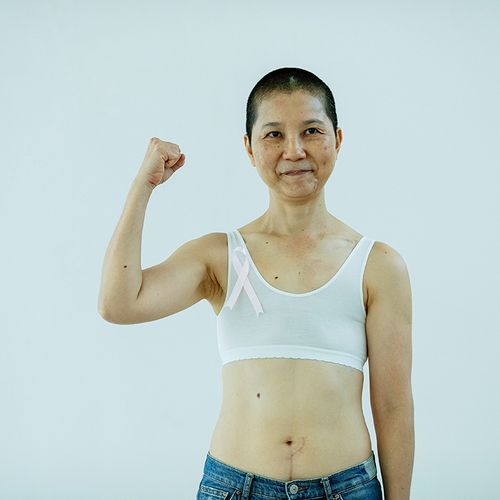Two recent surgical breakthroughs provide good news and new options for breast reconstruction after mastectomy.
If a loved one is facing breast cancer surgery, please pass along this information. Don't assume she already knows-sadly, only 30% of patients are fully informed about their options for reconstruction prior to their breast cancer surgery, according to a study from the University of Michigan.
For details on these surgical advances, we contacted Frank J. Della Croce, MD, cofounder of the Center for Restorative Breast Surgery in New Orleans, who pioneered the new techniques. Here's what women should know about…
- Nipple-sparing mastectomy. Traditionally, mastectomy has meant surgical removal of the entire breast...and reconstruction has included the need to rebuild a nipple by grafting skin from elsewhere and tattooing the area to simulate the areola (the colored ring around the nipple). However, with the new nipple-sparing mastectomy (NSM), the surgeon preserves the breast skin and nipple area while removing the underlying breast tissue, including the cancer, through a small incision below the nipple. This is immediately followed with breast reconstruction using either an implant, a "flap" procedure (described below) or another technique to fill the pocket of breast skin-so the woman leaves the operating room with the cancer gone and the reconstructed breast already in place.
While no reconstruction technique can guarantee a breast that looks exactly as it did before surgery, NSM minimizes scarring...provides optimal cosmetic results...and helps women feel more "whole" after surgery, Dr. Della Croce said. (For before-and-after photos, visit www.breast center.com/nipple-sparing-mastectomy.pbp and click on "View Result Photos.")
After NSM, sensation in the nipple may be reduced or eliminated, but results vary and many women report a substantial return of touch sensation in the months after surgery. What about the risk for cancer recurrence? "All studies to date, from multiple institutions, have shown equal cure rates with preservation of the nipple as compared with techniques that sacrifice it," said Dr. DellaCroce.
Who can benefit? While candidates for NSM must be evaluated case by case, the procedure generally is most appropriate for women who have relatively small areas of cancer that are a safe distance away from the nipple, Dr. DellaCroce said. NSM also may be considered when a woman opts to undergo prophylactic mastectomy because she is at very high risk for breast cancer due to a BRCA gene mutation.
- Stacked flap. To understand the new "stacked" procedure, you first need to know about the standard deep inferior epigastric perforator flap breast reconstruction technique. With the standard procedure, a flap of complete tissue-blood vessels, skin and fat-is taken from the abdominal area beneath the breast and used as a donor to reconstruct a breast of soft, warm, living tissue. But this may not work well for thin women who are full-breasted, as they may not have adequate abdominal tissue to reconstitute their breast volume, Dr. DellaCroce said. In such women, breast implants may be used to supplement the abdominal donor tissue-but implants can lead to complications, such as painful capsular contracture (hardening of tissue), which may require removal of the implant.
This is where the new stacked flap technique comes in-because it enables even thin women to have implant-free reconstruction using only their own natural tissue (without sacrificing abdominal muscle, as some other reconstruction techniques require). The procedure stacks two layers of abdominal fat under the preserved skin envelope by carefully connecting the blood vessels between them using microsurgery, Dr. Della Croce explained. This allows for full restoration of volume in the new breast.
Who can benefit? Thin women undergoing mastectomy who prefer not to use implants... and women who have had radiation treatment to the breast, for whom implants generally are not appropriate because of the likelihood of severe capsular contracture. "The stacked flap may be performed at the same time that mastectomy is performed. Or if mastectomy has already been done, the stacked flap can serve as a wonderful way to recreate a breast out of soft, living tissue at any point at which the patient is ready to proceed with restoration," Dr. DellaCroce said.
Finding a surgeon: Because NSM and stacked flap procedures are so new, you will need to hunt to locate a surgeon experienced with the technique you are interested in. To start, get referrals from the American Society of Plastic Surgeons (www.plasticsurgery.org), then interview several candidates. Dr. Della Croce recommended choosing a surgeon who confirms that he or she has done at least one per week for a full year of the procedure you're considering and whose success rate exceeds 95%. Also, ask to see photos of the surgeon's work...and get contact information for several patients who have undergone the same procedure so you can ask them about their experiences.
Having the option of reconstruction can be an important facet in a patient's full recovery. Dr. Della Croce said, "When you lose some component of your physical self, you also lose some of your emotional self. To have the breast rebuilt erases some of the injury of a very difficult event." And that makes the victory of surviving breast cancer all the sweeter.
Common Treatment Creates More Complications
Common breast cancer treatment brachytherapy may cause more complications than traditional external-beam radiation therapy (EBRT). Brachytherapy involves placing radioactive material inside the breast. The treatment usually lasts a week. EBRT projects radiation from a machine outside the body and usually is done over four to six weeks. Researchers estimated the complication rate to be 16.8% higher with brachytherapy than with EBRT.
